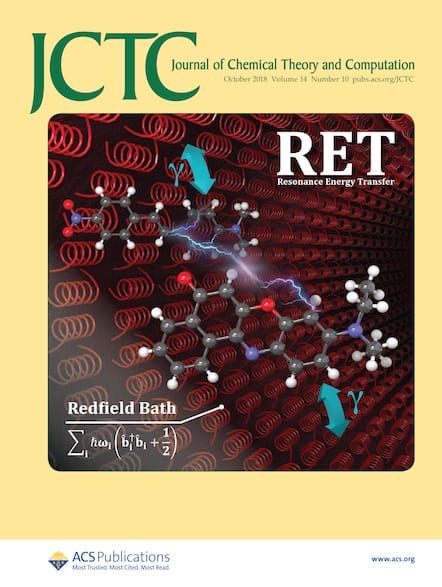上阶TICA和分数阶非马尔可夫过程对异常动态体系的建模。
IF 5.7
1区 化学
Q2 CHEMISTRY, PHYSICAL
引用次数: 0
摘要
时滞独立分量分析(TICA)与马尔可夫状态模型(MSM)技术的耦合已成为研究复杂分子系统动力学的一种行之有效的方法。识别与分子功能相关的慢模式,量化慢动力学所涉及的特征时间,预测动力学性质是这些方法应用的基本框架。在该领域目前的研究进展中,主要致力于制定方法来改进从轨迹数据近似动力系统传递算子的主要特征函数,并将记忆效应纳入MSM分析。沿着这些研究路线,在TICA- msm方法的框架内提出了各种发展:提出了选择动态信息分子内距离的准则和使用它们构建TICA(上阶TICA)的最优非线性基集的方法,以克服对传递算子特征函数的线性近似的限制。然后,引入分数阶非马尔可夫过程来处理以非指数松弛为特征的异常动态系统。分数过程用状态概率时间演化的主方程中非整数阶α >的时间导数来描述,它用时间变量中的mittagg - leffler函数代替了典型的马尔可夫过程的时间指数衰减。这种时间依赖性更适合于捕捉异常动力学的特征,通常通过实验和模拟在蛋白质和肽中观察到。该理论以研究人员在应用MSM分析时熟悉的形式进行,允许对转移概率矩阵进行直接操作。此外,该技术允许我们检查分子动力学(MD)轨迹中编码的动力学是否发生在异常状态,并且,在这种情况下,允许通过识别非马尔可夫过程的适当分数阶α来量化和处理异常。纯马尔可夫动态状态是所提理论的特殊情况,可以通过令α = 1来恢复。由D.E. Shaw Research (DESRES)提供的chignolin (a)、绒毛蛋白(b)和Trp-cage (c)蛋白的基准MD轨迹,根据提出的发展重新进行了研究,案例(a)和(c)表明,根据分数非马尔可夫过程描述系统动力学的能力是必要的,以获得在异常状态下发生的分子动力学的更准确的定性和定量图像。本文章由计算机程序翻译,如有差异,请以英文原文为准。
Upper-Order TICA and Fractional Non-Markovian Process to Model Anomalous Dynamic Regimes.
The coupling of time-lagged independent component analysis (TICA) with the Markov state model (MSM) technique has become a well-established route to study dynamics in complex molecular systems. Identification of the slow modes relevant to the molecular functions, quantification of the characteristic times involved in the slow dynamics, and prediction of dynamic properties are the basic frame of application of such methods. Among the current research developments in the field, great activity is devoted to the formulation of methods to improve approximation of the leading eigenfunctions of the transfer operator of a dynamical system from trajectory data and to include memory effects into MSM analysis. Along these lines of research, various developments are proposed here, in the framework of TICA-MSM approaches: a criterion to select dynamically informative intramolecular distances and a method to use them to build optimal nonlinear basis sets for TICA (upper-order TICA) are presented to overcome the limitations of linear approximations to the transfer operator eigenfunctions. Then, a fractional, non-Markovian process is introduced to deal with anomalous dynamic regimes characterized by nonexponential relaxations. The fractional process is described in terms of a time derivative of noninteger order α > 0 in the master equation of the temporal evolution of the states' probabilities, which replaces the exponential decay in time, typical of Markovian processes, with Mittag-Leffler functions in the temporal variable. This kind of temporal dependency is more appropriate to capture the characteristics of anomalous dynamics, often observed in proteins and peptides by both experiments and simulations. The theory is cast in a form that the researchers are familiar with when applying MSM analysis, allowing direct manipulations over the transition probability matrix. Moreover, the technique allows us to check whether the dynamics encoded in the molecular dynamics (MD) trajectory occur in an anomalous regime or not, and, in case, permits to quantify and treat the anomaly by identifying the appropriate fractional order α of the non-Markovian process. Purely Markovian dynamic regimes are special cases of the proposed theory and can be recovered by letting α = 1. The benchmark MD trajectories of chignolin (a), villin (b), and Trp-cage (c) proteins, provided by D.E. Shaw Research (DESRES), are revisited in light of the proposed developments, and cases (a) and (c) show that the ability to describe the system dynamics in terms of fractional non-Markovian processes is necessary to obtain a more accurate qualitative and quantitative picture of molecular dynamics occurring in anomalous regimes.
求助全文
通过发布文献求助,成功后即可免费获取论文全文。
去求助
来源期刊

Journal of Chemical Theory and Computation
化学-物理:原子、分子和化学物理
CiteScore
9.90
自引率
16.40%
发文量
568
审稿时长
1 months
期刊介绍:
The Journal of Chemical Theory and Computation invites new and original contributions with the understanding that, if accepted, they will not be published elsewhere. Papers reporting new theories, methodology, and/or important applications in quantum electronic structure, molecular dynamics, and statistical mechanics are appropriate for submission to this Journal. Specific topics include advances in or applications of ab initio quantum mechanics, density functional theory, design and properties of new materials, surface science, Monte Carlo simulations, solvation models, QM/MM calculations, biomolecular structure prediction, and molecular dynamics in the broadest sense including gas-phase dynamics, ab initio dynamics, biomolecular dynamics, and protein folding. The Journal does not consider papers that are straightforward applications of known methods including DFT and molecular dynamics. The Journal favors submissions that include advances in theory or methodology with applications to compelling problems.
 求助内容:
求助内容: 应助结果提醒方式:
应助结果提醒方式:


